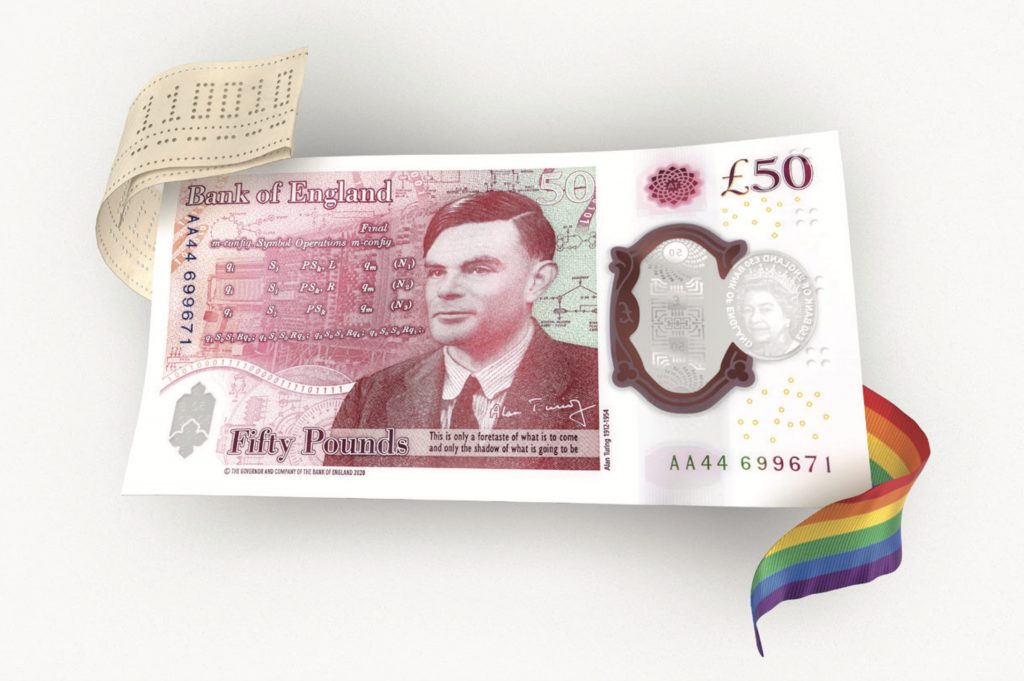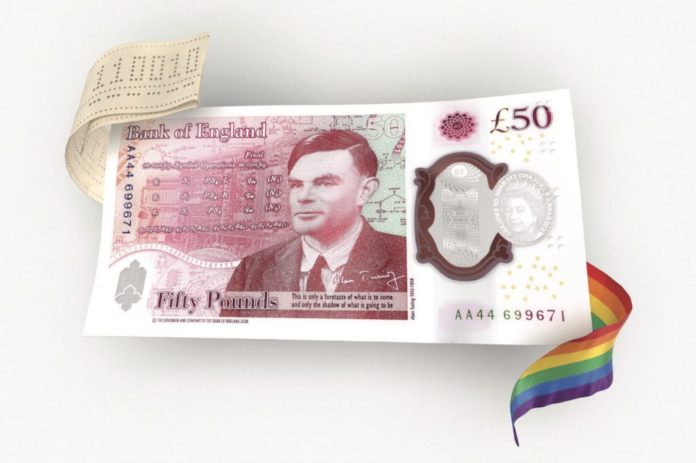Alan Turing leaves behind a legacy that is every bit as fascinating and complex as the codes and mathematical problems he engaged with during his life.
He is renowned the world over, in large part thanks to the Hollywood retelling of his story in the 2014 film The Imitation Game starring Benedict Cumberbatch as the titular hero.
But the reality is much more nuanced, and far more fascinating, than the rose-tinted cinematic portrayal of the man who’s come to be known as the father of computer science.
Turing’s contribution to the nation is set to be prominently recognised when he is featured on the new £50 note from 23rd June as its design undergoes a refresh.
The note is the most valuable of the four denominations printed by the Bank of England and is the final one in the series to make the transition from paper to polymer.
And 23rd June is significant as it would’ve been Turing’s 109th birthday.
So, what is it about the man that’s led to him being featured on our most valuable bank note? What makes Turing’s story such a fascinating one? And why has he become the stuff of Hollywood legend?
First, let’s deal with the latter.
Turing was undoubtedly an incredible individual. He was a visionary as well as a revolutionary.
The fact that his work and thinking is still relevant to huge swathes of everyday life in modern Britain is testament to just how radical his approach to problem-solving was.
His contribution to codebreaking at Bletchley Park in Bedfordshire is widely credited with shortening the Second World War by at least two years, and his work alongside others undoubtedly helped save many lives as a result.
What is equally remarkable is that the questions posed by aspects of his personal life are similarly relevant and worthy of discussion.
Alan Turing was a gay man, and this wasn’t legally acceptable in 1950s Britain.
In March 1952, he was convicted of gross indecency for his relationship with another man, and he only avoided prison by submitting to chemical castration.
His security clearance was revoked – for no reason other than his homosexuality – and a promising career as a consultant for GCHQ was brought to a close as a result.
It wasn’t until 2009 that the government formally apologised for the treatment Turing received, with prime minister Gordon Brown describing his ordeal as horrifying and utterly unfair.
Brown said in his statement at the time: ‘We’re sorry, you deserved so much better.’
However, it then took a further four years for Turing to be granted a posthumous royal pardon, and finally in 2017 a law was passed in his name allowing tens of thousands of other men convicted of historical gay sex offences to also apply for a formal pardon.
Alan Turing died in 1954, and yet well over seven decades since his passing, society has only just begun to correct the wrongs that he and those like him faced.
For a man who was officially recorded as being a criminal until very recently, to be featured on a bank note is a turnaround so swift that even Turing himself would surely be impressed if he’d been around to witness it.
The important point this raises, however, is that the tragedy of his treatment – and that of thousand of other gay men – is still something that is being faced today.
Society has moved on. Modern Britain is more inclusive. Groups like Stonewall, and initiatives like Pride, demonstrate there has been huge progress towards creating a society in which everyone can be themselves.
But we’re not quite there yet.
That’s why Turing’s story is so important. In many ways it isn’t about him. It’s about the power it has to inspire and the strength it has to give confidence to those who follow in his footsteps.
In telling Turing’s story, there are other injustices to note too – most obvious of all is that history and Hollywood have given him a spotlight some may argue should shared with the large collective of talented individuals who worked Bletchley Park.
His nephew Dermot Turing discusses the point frequently in his writing and lectures, and believes that sometimes perception can creep in as source of reality when talking about Turing.
He said: “There’s an element of sort of over-inflating what his contribution was. I don’t deny that he had an important one, but he was part of a team.
“That gets sort of turned into some kind of myth about Alan Turing personally saving millions of lives in World War Two, which is clearly nonsense.
“The amazing machine that he partly invented wasn’t exclusively his brainchild. The fact is that he wasn’t the engineer on the project.”
He cautioned: “I think we have to just be a little bit wary of what we see when we go to the movies.”
He went on to explain that the historical and Hollywood narratives largely fail to tell the full story of the many women at Bletchley Park too, whose contribution is often overlooked as a result of the way their job titles were recorded.
He said: “There were plenty of women who were doing the same codebreaking jobs as the men, you know, really high powered stuff which was difficult and required imagination and all those kinds of skills that you associate with people like Turing.
“The problem has been that when the historians goes to the National Archives and they look at the records they see the job titles that were given to women were things like translator and clerical staff and typist.
“And that’s only because women were on a different pay scale, and the codebreaker grades were reserved for men, so the women who were doing codebreaking couldn’t be called codebreakers.
“So you get a false impression about what people were doing.”
I put this same point to Kirstie Whitaker – the programme lead for open source tools, practices and systems at The Alan Turing Institute, an organisation committed to ensuring data science and AI changes the world for the better.
She said: “I think that’s another great example of where historically we haven’t paid attention to, and supported, both women but members of other underrepresented groups as well.”
She added: “There were so many women – working on shifts, and literally 365 days a year – supporting that effort, breaking the codes, doing the translation.
“It’s great to remember them, and in our work at the Turing Institue we do focus on making sure that we tell those stories.
“One of the things that I’m very, very passionate about is the importance of invisible work.
“So, that’s work to train people to support and empower – to make sure that others have the information that they need.”
But recognising that he was part of a team shouldn’t diminish the impact Turing had. He was a truly remarkable figure and wasn’t confined in his work to just one discipline.
Kirstie told me: “As a scientist, he moved around different domains to find the most challenging questions.”
“He wrote about the concept of computational numbers and was part of creating the first computer.
“He then also worked on the war efforts in terms of encryption and decrypting the enigma code which a lot of people will know about applying skills from mathematics, and then later on in his career he switched to studying biology and biochemistry.”
Whitaker explained: “I think what he was doing was basically saying: ‘I have some skills, I’m a smart person, and I’m very, very curious, so I’m really interested in trying to work on the most interesting problems and I’m not really limited by what specific domain boundaries exist’.”
She added: “I think that’s exactly what The Turing Institue is trying to do, trying to break down some of those boundaries, and to share that innovation and encourage everybody to focus on the mission, on the purpose of the research rather than what has been done before, or being constrained by who has done it.”
Before making its decision to include Turing on the new £50 note, the Banknote Character Advisory Committee received 227,299 nominations, covering almost 1,000 eligible characters.
It said its 12 shortlisted options demonstrated a breadth of scientific achievement in the UK – and it’s clear that Turing was at the pinnacle of that.
The new bank note was revealed at an event hosted by the Science and Industry Museum in Manchester.

The museum is now reopening its doors with an exhibition entitled Top Secret, which chronicles the history of espionage and is being organised in collaboration with GCHQ.
Associate curator Abigale Wilson told me: “Alan Turing is a really key figure in the history of communications intelligence for his work at Bletchley Park, under the government code and cypher school which is the predecessor of GCHQ.”
She said: “He’s also really important for Manchester, because after the Second World War he came to the city and joined the University of Manchester.”
She added: “Turing did some of his most creative thinking while he was in Manchester: thinking about artificial intelligence, the Turing Test and also sequences and patterns in nature.
“He used one of the early computers, part developed at Manchester University and Ferranti, to do some of that work on sequencing in in nature.
Alan Turing is one of those rare people whose legacy is both personal and professional, and he also connects north and south – with both Bedfordshire and Greater Manchester having strong links to his life and work.
His inclusion in the Bank of England’s set of bank notes helps chart how far we’ve come, as well as how much further we still have to go.
But, perhaps it’s best to let Alan Turing have the final words… “This is only a foretaste of what is to come and only the shadow of what is going to be.”








